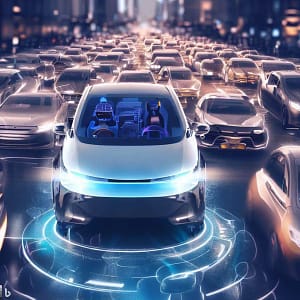Introduction
In the not-too-distant past, self-driving automobiles were only an idea reserved for science fiction novels and futuristic films. However, fast advances in Artificial Intelligence (AI) and sensor technology have propelled self-driving automobiles from science fiction to our everyday reality. In this detailed blog post, we will delve into the fascinating realm of self-driving cars. Let’s delve into the autonomous revolution that’s transforming the future of mobility, from its technology and benefits to the problems it faces and its potential to change transportation.
The Technology Behind Self-Driving Cars
A sophisticated blend of AI, machine learning, computer vision, and sensor technologies is at the heart of self-driving automobiles. These cars are outfitted with a variety of sensors, including Lidar, cameras, radar, and ultrasonic sensors, which allow them to detect their environment and make judgments in real time. The sensor data is processed by advanced AI algorithms, which create a precise map of the area and guide the vehicle’s movements.
Advantages of Self-Driving Cars
Accessibility
Self-driving cars hold the promise of providing mobility to those who cannot drive, including the elderly and differently-abled individuals, granting them newfound independence.
Congestion Reduction
Autonomous vehicles can communicate with one another as well as with traffic infrastructure such as traffic lights and road sensors. This enables them to coordinate their motions and improve traffic flow, potentially alleviating congestion on congested roadways.

Safety
Autonomous vehicles have the ability to cut traffic accidents significantly. This is because they are resistant to human flaws like intoxicated driving, inattentive driving, and weariness.
Environmental Benefits
By optimizing driving patterns and reducing aggressive driving habits, self-driving cars have the potential to reduce emissions and contribute to a greener future.
Challenges and Concerns
Safety and Liability
Safety is one of the most challenging aspects of self-driving cars. These vehicles must be able to handle a variety of situations, including unexpected events. AI systems must be able to learn from experience and adapt to changing conditions. Additionally, determining liability in the event of an accident involving an autonomous vehicle poses legal challenges.
Regulation
Another challenge facing autonomous cars is regulation. Governments need to develop rules with the intention of ensuring the safety of self-driving vehicles. These policies will need to not forget the unique types of independent cars which can be being evolved.
Ethical Dilemmas
Programming AI to make complex ethical decisions, such as choosing between different life-saving options, raises intricate moral questions.
Infrastructure Adaptation:
To fully harness the potential of self-driving cars, our transportation infrastructure must be upgraded to accommodate autonomous vehicles.
Acceptance
Finally, autonomous cars need to be accepted by the public. Many people are hesitant to trust self-driving cars, and there is a need to educate the public about the benefits of autonomous cars.
The Road to Widespread Adoption
Regulatory Framework
Establishing clear and uniform regulations for self-driving cars is essential to build public trust and facilitate their integration into mainstream transportation.
Public Perception
Addressing public apprehensions and raising awareness about the safety and benefits of autonomous vehicles are key to fostering acceptance.
Gradual Integration
The transition to fully autonomous driving may be gradual, with increasing levels of automation introduced in stages.
Industries Impacted by Self-Driving Cars
Automotive Industry
Self-driving cars are transforming the automobile industry, forcing manufacturers to innovate and work with technology companies to stay competitive.
Transportation and Logistics
Autonomous cars have the potential to revolutionize the logistics business by cutting costs and improving delivery operations.
Urban Planning and Real Estate
Self-driving cars will have an impact on urban design and real estate dynamics, potentially lowering the requirement for large parking spaces.
Conclusion
Self-driving cars are rapidly advancing and being tested, and it is clear that they have the potential to revolutionize the way we travel, work, and interact with our environment. While there are still challenges to overcome, the benefits of improved safety, reduced congestion, and increased accessibility make the autonomous revolution an inevitable step in the transportation landscape.
As we move forward, collaborative efforts from governments, businesses, and society as a whole will be essential to realizing the full potential of self-driving cars.



